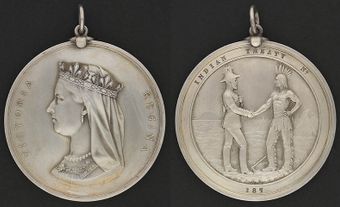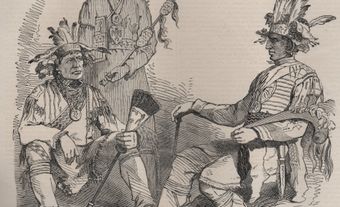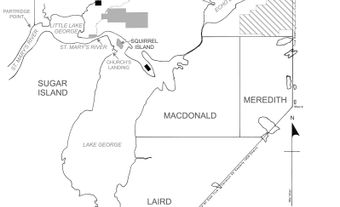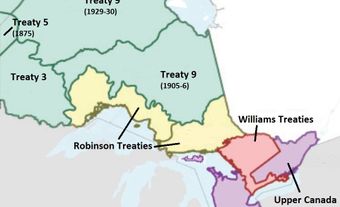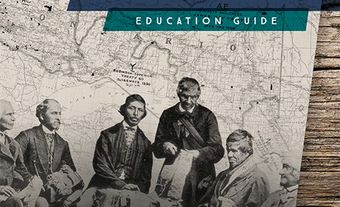The Upper Canada Land Surrenders (sometimes known as the Upper Canada Treaties) is a title given to a series of agreements made between Indigenous peoples and the Crown. These agreements were made during the late 18th century and into the 19th century before Confederation and the creation of the province of Ontario. The agreements surrendered Indigenous lands to the colonial government for a variety of purposes, including settlement and development. The Upper Canada Land Surrenders cover much of what is now southwestern Ontario. (See also Treaties with Indigenous Peoples in Canada.)

Terminology: Treaties and Land Surrenders
There are various words used to describe agreements made between the Crown and Indigenous peoples. These include, treaties, land surrenders, land cessions and purchases.
Treaties are agreements made between Indigenous peoples and various levels of government. They define continuing treaty rights, recognized in section 35 of the Constitution Act, 1982. Often, treaties include, among other provisions, the transfer of land from Indigenous peoples to the government. However, this is not always the case; for example, the Peace and Friendship Treaties (1725-79) contained no monetary or land transfer provisions but guaranteed certain rights.
Land surrenders, also known as land cessions, describe an agreement that “gives up” Indigenous territory to the government. Land surrenders are often included in treaties, and in some cases, are themselves referred to as treaties. In other cases, however, land surrenders are not treaties at all; rather, they are sales of land (sometimes known as “purchases”) that offer no on-going payments or gifts to Indigenous peoples. Land surrenders can also refer to land being sold on a reserve — these agreements are also not considered treaties.
Historical Context
The Royal Proclamation of 1763 established the basis for governing the North American territories surrendered by France to Britain in the Treaty of Paris, 1763, following the Seven Years’ War. The Royal Proclamation set the constitutional structure for the negotiation of treaties with Indigenous peoples in Canada.
In 1764, the Seneca signed a treaty with the Crown in what was likely the first land surrender after the Royal Proclamation. It gave the British access to lands on the Niagara River for the purposes of transportation and communication. Early agreements such as this were often about maintaining alliances with Indigenous peoples. Subsequent treaties, including those after the American Revolution (1775—83) and War of 1812, were increasingly about surrendering lands for settlement, as supporters of the British (including the Loyalists) came to Upper Canada looking for a new home. In many of these treaties, Indigenous peoples received cash payments (either one-time or annual, depending on the agreement), reserves (in some cases) and other goods in return for the surrender of their traditional lands. (See also Reserves in Ontario.)
By the mid-1830s, treaties covered most of the arable lands in Upper Canada. Presumably the last land surrender in Upper Canada was signed in 1862, ceding most of Manitoulin Island. ( See also Wiikwemkoong Unceeded Territory.) By the time of Confederation in 1867, nearly all of Ontario was covered by a treaty.
Disputes
The Indigenous signatories of the Upper Canada Land Surrenders included many Anishinaabe peoples, the Huron-Wyandot, and other First Nations. Some descendants of the Indigenous signatories claim that their traditional territories were unjustly taken. For example, the Mississauga argued that the Toronto Purchase, originally negotiated in 1787, covered unceded territory. Disputes led to a revised treaty in 1805 and a final settlement in 2010. In the case of Wiikwemkoong First Nation, a 1997 land claim argued that the Manitoulin Island Treaty of 1836 affirmed the band’s right to the islands off the eastern shore of Manitoulin, which were never ceded. For many treaties, disputes between Indigenous peoples and the Crown continued well after the initial agreements were signed.
List of Land Surrenders
The total number of Upper Canada Land Surrenders differs depending on the source, but most agree that there are 30 to 40. The following list accounts for only those land surrenders not associated with other treaties in Ontario, such as some of the Numbered Treaties, the Williams Treaties and the Robinson Treaties. Some of the treaties listed below cover areas of land outside of what was Upper Canada.
- Michilimackinac Island Treaty, also known as Treaty 1 (1781) *Not to be confused with Treaty 1 of the Numbered Treaties.
- Niagara Purchase, also known as Treaty 381 (1781)
- Crawford Purchase (1783)
- Crown Grant to the Mohawks of the Bay of Quinte, also known as Treaty 3½ or the Simcoe Deed (1784)
- John Collins' Purchase of 1785
- Treaty 116 (1786)
- Johnson-Butler Purchase (1788)
- McKee's Purchase, also known as McKee Treaty and Treaty 2 (1790) *Not to be confused with Treaty 2 of the Numbered Treaties
- Between the Lakes Purchase and Collins Purchase, also known as Treaty 3 (1792) *Not to be confused with Treaty 3 of the Numbered Treaties
- Crown Grant to the Six Nations, also known as the Haldimand Tract or Treaty 4 (1793) *Not to be confused with Treaty 4 of the Numbered Treaties
- Treaty 3 ¾ (1795)
- Treaty 8 (1797) *Not to be confused with Treaty 8 of the Numbered Treaties
- London Township Treaty, also known as Treaty 6 (1796) *Not to be confused with Treaty 6 of the Numbered Treaties
- Sombra Township Treaty, also known as Treaty 7 (1796) *Not to be confused with Treaty 7 of the Numbered Treaties
- Penetanguishene Treaty, also known as Treaty 5 (1798) *Not to be confused with Treaty 5 of the Numbered Treaties
- St. Joseph's Island Treaty, also known as Treaty 11 (1798) *Not to be confused with Treaty 11 of the Numbered Treaties
- Treaty 12 (1800) *Not to be confused with Treaty 12 of the Numbered Treaties
- Toronto Purchase, also known as Treaty 13 (1805)
- Head of the Lake Treaty, also known as Treaty 14 (1806)
- Lake Simcoe Treaty, also known as Treaty 16 (1815)
- Nottawasaga Purchase, also known as Lake Simcoe-Nottawasaga Treaty or Treaty 18 (1818)
- Ajetance Treaty, also known as Treaty 19 (1818)
- Rice Lake Treaty, also known as Treaty 20 (1818)
- Treaty 21 (1819)
- Treaty 22 (1820)
- Treaty 23 (1820)
- Treaty 25 (1822)
- Rideau Purchase, also known as Treaties 27 and 27 ¼ (1819-22)
- Huron Tract, also known as Treaty 29 (1827)
- Treaty 35 (1833)
- Manitoulin Island Treaty, also known as the Treaty of Manitowaning or Treaty 45 (1836)
- Saugeen Tract Purchase, also known as Treaty 45 ½ (1836)
- St. Regis Purchase, also known as Treaty 57 (1847)
- Saugeen Peninsula Treaty, also known as Treaty 72 (1854)
- Treaty 82 (1857)
- Manitoulin Island Treaty, also known as the McDougall Treaty or Treaty 94 (1862)

 Share on Facebook
Share on Facebook Share on X
Share on X Share by Email
Share by Email Share on Google Classroom
Share on Google Classroom


